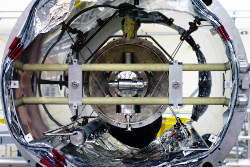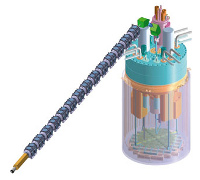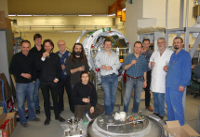 |
 |
|||||||||||||
|
|||||||||||||
|
|||||||||||||
What do the ILC and environmental protection have in common? The answer is: superconducting cavities. The European MYRRHA is an experimental facility aimed to demonstrate the technical feasibility of nuclear waste transmutation in an accelerator-driven system. The main part of the accelerator will consist in a series of superconducting cavities. At INFN Milano, Italy, a group has transferred all its experience from the TESLA Technology Collaboration and ILC for the development of elliptical proton cavities for this application. Last month, a prototype cryomodule containing one low-beta elliptical cavity was installed in dedicated test stand at the IPNO/Supratech technological platform in Orsay, France. The general objective of transmutation is the reduction of radiotoxicity, volume and heat load of high-level nuclear waste, which has to be put into final repositories. The question is: how to dispose of nuclear waste? Parts of radionuclides remain hazardous for more than a million years. Transmutation roughly means "burning" these isotopes to obtain waste products whose lifetime is in the order of about a few hundred years. The European accelerator-driven machine concept (ADS) requires a high-power proton accelerator, which delivers a proton beam onto a spallation target. The outcoming high-intensity neutron flux then feeds a sub-critical core (see image 2). The MYRRHA project (Multipurpose hybrid research reactor for high-tech applications), whose construction is foreseen in the years to come at Mol, Belgium, is aimed to demonstrate that coupling an accelerator with a nuclear reactor works. Two European labs, INFN/LASA (Laboratorio Acceleratori e Superconduttivitą Applicata) in Milano, Italy and IPNO (Institute of Nuclear Physics) a CNRS/IN2P3 lab at Orsay, France, worked on the design and construction of a 700-megahertz prototypical cryomodule for the ADS proton linear accelerator, within the European Union Framework 6 Project EUROTRANS. Last month, a team of INFN scientists and technicians arrived at Orsay to install the complete cryomodule prototype containing a so called "low-β(beta)" elliptical cavity in the IPNO/Supratech plateform test stand. The Italian team contributed to the design and fabrication of the superconducting cavity and ILC-type blade tuner (read more in ILC NewsLine about the installation of these tuners at KEK for ILC S1-global project). They also designed the cryomodule itself. The French team at IPNO developed the radiofrequency-power source, the cavity couplers and cryogenic components for the installation. EUROTRANS successfully finished this March with the delivery of the cryomodule prototype. "After years spent in meetings agreeing on blueprints and layouts, I'm happy to see all the pieces of our jigsaw ready to make our prototype design a reality," said Paolo Pierini, researcher at INFN/LASA. The 100 to 200 cavities superconducting elliptical cavities used at the end of the European ADS will be very different from the ILC's. The beam energy is relatively small — 600 MeV maximum (hence the use of "low-β" cavities, β being the velocity divided by the speed of light). They work at 700 megahertz (1.3 gigahertz for TESLA-type ILC cavities). However, much of the knowledge learned from the TESLA Technology Collaboration (TTC), the European XFEL and the ILC, in which INFN/LASA and IPNO has been involved for many years now was exploited to build the EUROTRANS cavity. First these cavities have the same elliptical shape as the Tesla-type ILC cavities and are also made of niobium. The cavity surface treatment recipes were copied from the FLASH Facility (at DESY) and ILC experiences. They used electron-beam welding, cleaning and chemical treatments. However, since the desired gradient is only eight megavolts per metre (compared to 31.5 megavolts per metre for the ILC), a "standard" buffered chemical polishing treatment was sufficient to guarantee the performance levels, sparing the difficult task to adapt the electropolishing technique – which has a greater potentiality in terms of high gradients – to the low-β structures. The ADS accelerator also brought specific issues to the IPNO and LASA experts. The fact that the neutron beam finally fires on sub-critical reactor requires that the proton beam function is a continuous mode with a very limited number of interruptions: less than five stops of more than one second per year. “As accelerator experts, we discovered a new culture while working in close collaboration with nuclear plants teams,” said Jean-Luc Biarrotte, an engineer working at the Accelerator Division of IPNO. “We were used to design accelerators without such stringent requirements on reliability.” To reach the extremely ambitious reliability goals, the accelerator engineers had to work hard to follow new reliability-oriented practice. Final tests of the prototype are being performed at Orsay this month and they hope to conclude soon on promising results towards the realisation of the MYRRHA demonstrator. “This project is a nice by-product of the FLASH/ILC technology driven by high-energy physics, and an application of superconducting radiofrequency to contribute to live in a cleaner world, as we need more and more energy to maintain our lifestyle, and sustain the development of emerging countries,” concluded Pierini. “High radio-toxicity waste production remains a major environment topic and the ADS represents one possibility to reduce the production of spent fuel. Our collaborative activity is a small step towards this direction.” -- Perrine Royole-Degieux
Read about more possible benefits from the ILC technology.
|
|||||||||||||
| © International Linear Collider |



